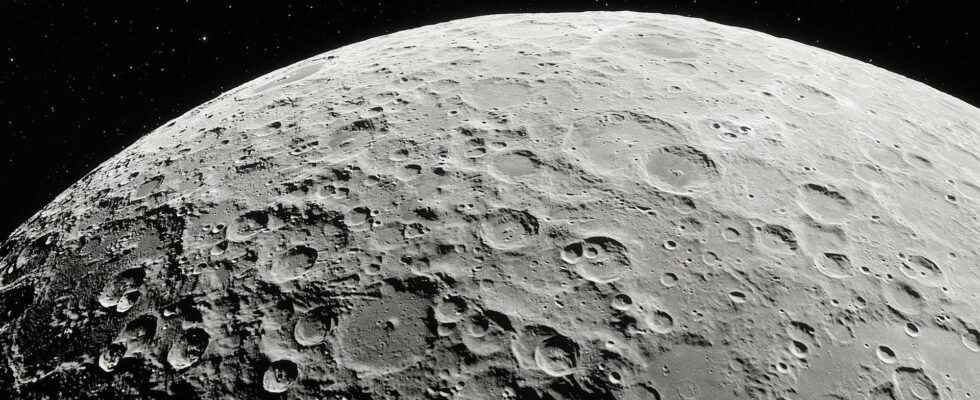A new study of craters on the surface of the Moon tends to associate the asymmetry between the two lunar faces with a massive meteorite impact at the level of its south pole, following the hypothesis that the latter would have thus motivated the volcanic processes at the level of its visible side, facing the Earth.
You will also be interested
[EN VIDÉO] GRAIL films the far side of the Moon First images taken by the GRAIL lunar probes showing the hidden side of the Moon. The dark side of the Moon is the one that we never see from Earth. © Nasa
The Moon constantly presents the same face to the Earth: it is locked by the effect of tide (its rotation period is equal to its period of revolution), and therefore has a dark side, invisible from Earth. The differences between the two faces were brought to light from the first overview of the face hidden by the Soviet probe Luna 3, in 1959: the scientists then discovered a rough and heavily cratered surface (called the highlands), unlike the visible face which is strewn with lunar seas – wide plains basalt dark and smooth in appearance.
Would different chemical compositions explain the lunar asymmetry?
But the elements that distinguish the two lunar faces are not only geomorphological: missions after Luna 3 also revealed significant differences in geochemical composition between the two faces. The visible side houses a anomaly of chemical composition called Procellarum KREEP Terrane (PKT), characterized by high concentrations of potassium (K), in rare earth (REE), in phosphorus (P) as well as other heat-producing elements such as thorium (Th). This anomaly is widely represented at and around the ocean of Storms (Oceanus Procellarum) and is globally found on the visible side, but seems much more scattered on the hidden side.
Scientists currently agree to point the finger at the chemical anomaly PKT to explain the dichotomy between the two lunar faces: characterized by high concentrations of heat-producing elements, this anomaly could have had the capacity to motivate late volcanic processes in the level of the visible side of our satellite. But the mechanism at the origin of this anomaly still remained unknown: also presenting high concentrations of incompatible elements (which tend to concentrate in the phase liquid when fractional crystallization of one magma), the elements characterizing the KREEP would consequently have crystallized last, and would thus have formed in a relatively uniform way the upper layer of the moon coat ; a new study seems to indicate that the meteorite impact at the origin of the formation of the South Pole-Aitken Basin (second largest impact basin in the solar systemlocated at the lunar south pole, and of which a small part is represented on the visible face – 2,500 kilometers in diameter for 12 kilometers in depth) could have redistributed the elements constituting the KREEP in a preferential way at the level of the visible face: indeed, the formation of the South Pole-Aitken basin seems to correspond temporally to the formation of the last lunar seas.
A colossal meteorite impact would have redistributed chemical elements around the Moon
The team of researchers then produced digital models to simulate the effect of vague of heat generated by such an impact on the interior of the Moon, and on a possible redistribution of KREEP elements. Their simulations have been shown to be largely conclusive: for any simulated impact scenario (from a direct and violent impact to a low impact speed and low angle), the amount of mobilized KREEP elements varies, but consistently results in high concentrations of these elements around the far side, consistent with observed KPT anomalies. Thus, scientists support the idea that the meteorite impact at the origin of the South Pole-Aitken basin would have made it possible to excavate matter into the coat upper, under crust.
And the dating arguments of different lunar structures on the visible side seem to support this idea: the counting of craters in the PKT zone indicates that this formation would be posterior to the formation of the impact basin of the south pole, and the basaltic seas oldest would be dated to -4.3 billion years (about 200 million years after the impact of Aitken); their model indeed shows a thermal asymmetry between the two faces over more than 600 million years after the impact, caused by the asymmetry in chemical composition and motivating volcanic processes on the visible face.
Support your independent scientific media: discover our subscription formulas!
4 good reasons to subscribe to Futura on Patreon:
- A site without any advertising from 3.29 euros per month.
- It is without commitment.
- Access to priority content, in preview, just for you.
- You support our business in the best possible way. A real motivation for us!
Interested in what you just read?
